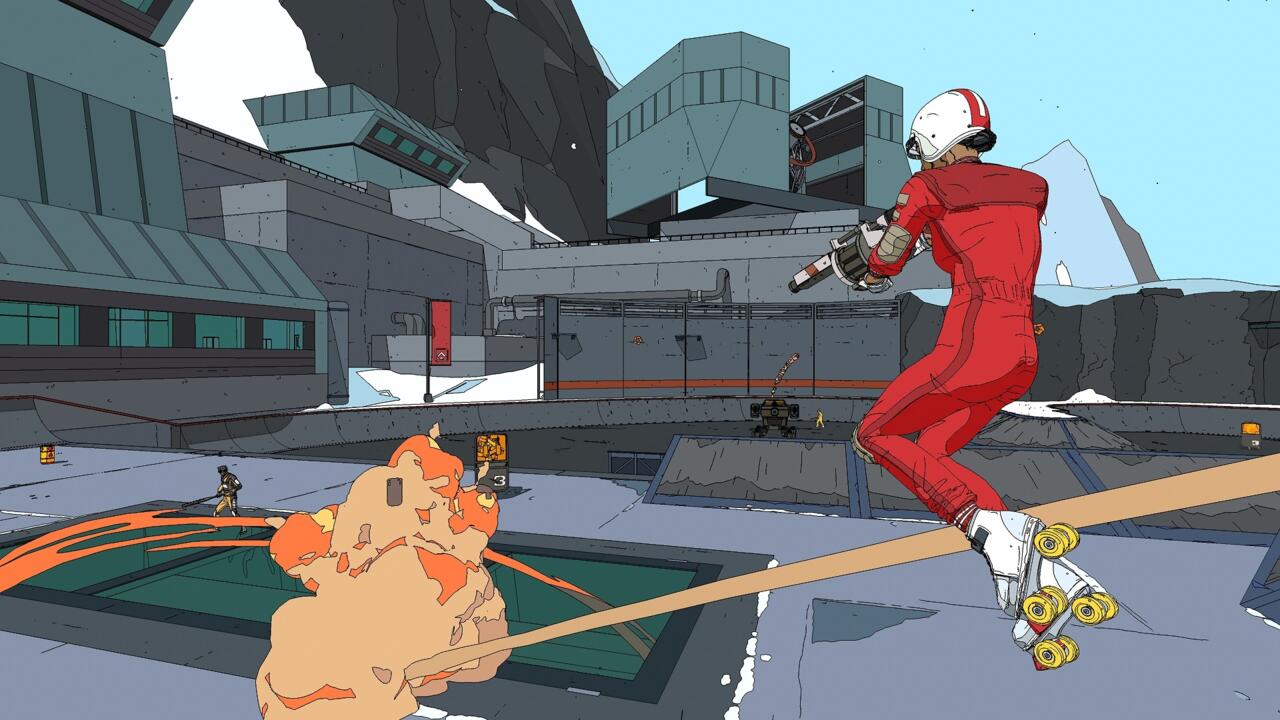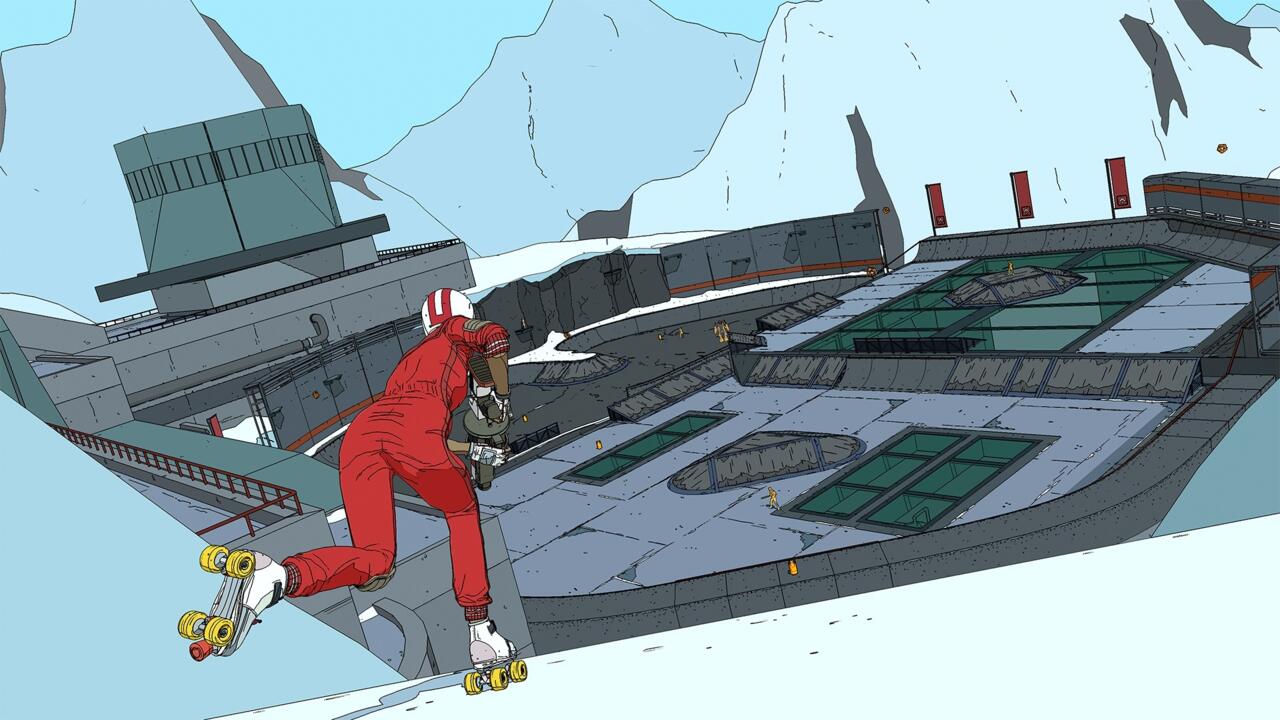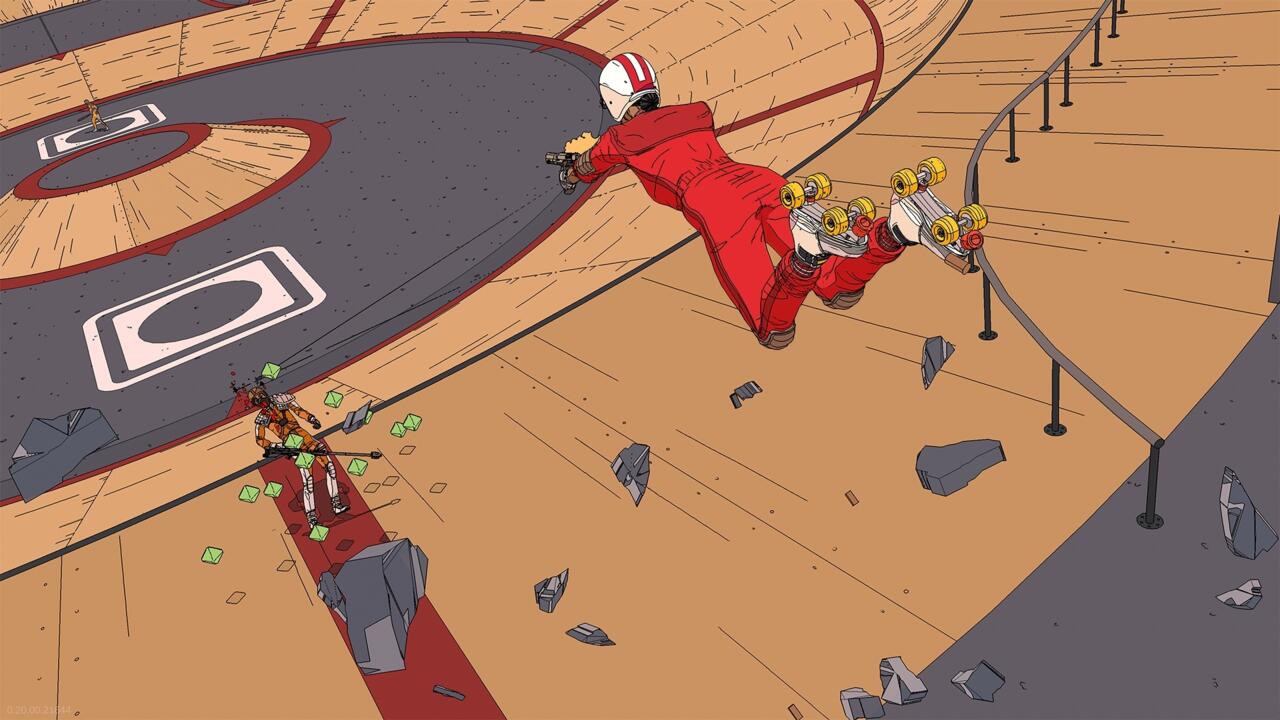Coming off the critical acclaim of skateboarding side-scroller OlliOlli World, you might ask, where could Roll7 go from here? The developer has a solid mastery of "flow state" games that are all about hitting jumps, performing tricks, and chaining sick moves together to log massive scores. What do you bring to that kind of game to create something new?
In the case of Rollerdrome, you make what might be the most video game decision possible: take the mix of skating, tricks, and high scores, and add a bunch of guns.
Rollerdrome trades skateboards for roller skates and side-scrolling courses for 3D arenas, but a lot of the underlying ideas are the same. Levels are full of half-pipes, ramps, and grind rails to give you opportunities to do grabs, flips, and spins. The more tricks you do, the higher your score gets, so the idea is to keep moving and to keep hitting sick moves to earn as many points as you can. It has the same feel as the OlliOlli series, or games like Tony Hawk's Pro Skater, giving you freeform opportunities to express yourself through mid-air artistry.
The big twist is that you're not alone in the arenas you skate in Rollerdrome--they're filled with enemies called House Players, whose goal is to murder you. Rollerdrome is a blood sport in which your goal in each level is to kill all the House Players before they kill you, and to look awesome doing it. Killing enemies also helps you maximize your score, because as you take out your opposition, you gain multipliers that increase the points you earn from landing tricks.

We played the first six levels of Rollerdrome, and found that once you get a feel for it, the game scratches the same high-score-chasing itch that makes the OlliOlli games great, with a side of violence and strategic thinking. Matches are filled with different kinds of enemies, none of whom are particularly smart, but all of whom require specific strategies to handle them. You want to stay away from the bat-wielding melee fighters, while getting in close on the deadly snipers before they can land their shots. Rocket launcher soldiers are best dealt with by shooting their own rockets out of the air, taking them out before they can protect themselves with force fields. Each arena introduces more enemy types and different combinations, and to maximize your score, you want to kill them all as fast as you can.
The idea that makes the whole formula work is the way Rollerdrome integrates tricks and gunslinging. Every time you land a trick, you receive ammo for your guns--the more advanced the trick, the more ammo fills your magazines. In order to keep your combos high and to knock out enemies, you also need to be thinking about not only your next target, but also the grind or flip you'll hit once they've fallen.
"We spent quite a long time on the project, especially early on, trying to figure out if it's a skater-shooter or a shooter-skater," said lead producer Drew Jones in an interview with GameSpot. "What are we? Mainly a shooter or mainly a skater? And basically where we ended up with is that we're a shooter first. But the skating is still very much an essential part of the experience. And really, if we've done our job, then the two parts of that should really complement each other and feed into each other in various ways."
Jones said the Rollerdrome development team spent something like the first year of the game's two-year development grappling with the shooter-or-skater question. And while Rollerdrome might fall a little more on the shooter side, it's the balance of those two elements that makes the game feel like more than just disparate ideas mashed together. Tying your ammo to the tricks you perform, and tying your kills to increasing the score you earn from tricks, creates a perfect bridge between third-person shooting and the high-scoring skater formula. It's an organic way for both halves of the experience to complement each other. A big part of what makes that balance work so well is the fluidity the game achieves.

Like OlliOlli World, Rollerdrome manages to keep the mechanical execution of its shooting and skating relatively simple. The tough part of the experience is keeping awareness of your surroundings so you can avoid House Players' attacks and keep racking up points. To help you keep your focus on the more interesting parts of the game, like planning your course through the arena, identifying threats, and setting up for your next trick, Roll7 keeps aiming pretty simple; you'll automatically target enemies near you so you can fire away. Forward motion is also automatic, requiring only that you steer where you're going, so you don't have to continually tap a button or push on an analog stick to maintain your momentum.
"A phrase that came up a lot during development was the term 'cognitive load,' the amount that we are placing on the player to do all the things that need to happen in this bloodsport," Jones explained. "And we definitely didn't want to overwhelm or overload the player. At Roll7, we pride ourselves on making games where hopefully the players enter a flow state. And if the player's got too much on their mind, we know that they're not going to achieve that because they're going to have to lean too far in. And we need them in that sweet spot of not too disengaged where it's just trivial, but not so far in that it's stressful."
That also meant removing elements that can break the flow. Early in development, Jones said, Rollerdrome included the concept of "bailing"--messing up a trick or landing awkwardly, causing the player to fall. It's something that's core to the OlliOlli games, but an element that killed the momentum, and thus the fun, of Rollerdrome. If you land on your head mid-flip in an arena, your character just does a quick summersault and hits their feet again. Making sure you actually land tricks is still important from a score perspective, but for the developers, keeping momentum for the player was essential to keeping the game fun.
Though the whole game is pretty fast-paced, a lot of Rollerdrome's challenge comes from trying to be aware of your 360-degree surroundings even when you can't see them. To help you deal with that, the game includes a short-term focus ability that slows down time when activated, giving you a few seconds to survey the battlefield or react to an incoming shot. Tricks, too, are fairly easy to complete, dictated by tapping different directions on the left analog stick while holding other buttons to execute certain grabs or grinds. But while the controls themselves keep things simple, all the small, easy-to-do actions pile up into a complex whole.

The six Rollerdrome levels we played took us through several different arenas, each with its own designs, like a mall full of escalators and walkways that provide a bunch of grind rails, or a rooftop at a ski resort with a big gap between its two sides that you need to jump over. Each level also includes various Tony Hawk-like challenges, including snagging collectibles, performing particular tricks, and killing enemies in specific ways. Completing challenges opens the way to future levels, so you'll need to manage some level of mastery of each of the arenas before you can move on to others.
Most of Rollerdrome is just about shooting enemies and keeping your momentum up, but underlying your climb up in the championship Rollerdrome circuit is a background story of skater rivalries and corporate conspiracy. As you might expect, Rollerdrome draws a lot from 1970s cinema and comics--it's a whole lot like the 1975 movie Rollerball, which is also about a roller derby bloodsport. One big, ever-present force in the Rollerdrome world is Matterhorn, the unfeeling corporation sending people to their deaths in its skate-and-shoot competitions.
The narrative is generally understated, however, requiring you to glean tidbits from certain scenes and to see how they inform the competition you're taking part in. The game is set in the near-future of 2030 as imagined in 1979, as Jones put it, and puts you in the role of an up-and-coming competitor. Between each new tier of matches as you try to take the Rollerdrome championship, you'll have short scenes in spaces like an arena's locker room or the green room at a TV station before a big interview. Those places are filled with items you can find, like messages left by other characters, and clues as to what Matterhorn is up to and what the greater world is like.
As Jones noted, the narrative serves to answer the question, "Why am I on roller skates, holding a grenade launcher?" But it's also very much optional, and presented in a way that rewards your willingness to explore its corners and discover all the clues you can, but which also allows you to sail right past if you're so inclined.

"In the same way that our levels are built in such a way that we never really want to interrupt your flow... we wanted the same thing with the narrative, to very much to not interrupt the game play, but to flow in with it," said David Jenkins, Roll7's head of quality assurance. "So you have the choice then to stop for a moment and have a look and have a breather, I suppose, as well."
If you're willing to put in a couple minutes to explore the story, Rollerdrome seems to do a lot with a little. Notes, news articles, announcers on the radio, posters, standings listings--they all give you a sense of the personal stories of the other skaters and the fame and fortune they can earn by fighting so hard. But there are also groups who are protesting Matterhorn's practices, and skaters who support them, and you can find tidbits that suggest things don't go so well for those who speak out. In fact, the overall tale seems to be one of a sinister Matterhorn tightening its grip on the world, and doing so with the spectacle and bloodshed of its popular competition.
At least in the early portion of Rollerdrome, Roll7 creates an excellent combination of gameplay systems that are fast and fun to engage with, using some of the best elements of skating games to put a different spin on third-person shooters. Its '70s aesthetic and low-key mystery complement some deceptively simple shooter gameplay that's great for building unexpected challenges and creating a compulsion to chase higher scores. We'll have to see just how well all those elements blend together throughout the game's campaign, but this early portion suggests a promising, intense shooter-skater experience.
Rollerdrome releases on PlayStation 4, PS5, and PC on August 16.










